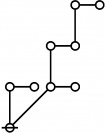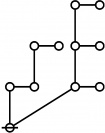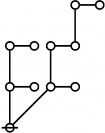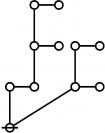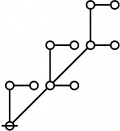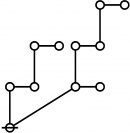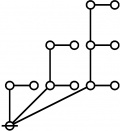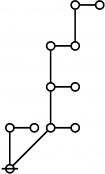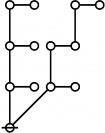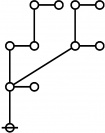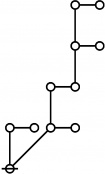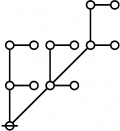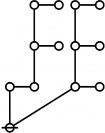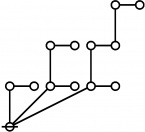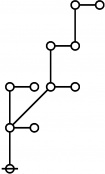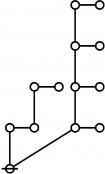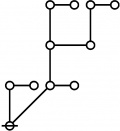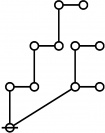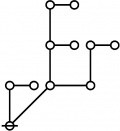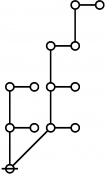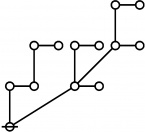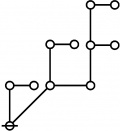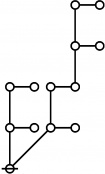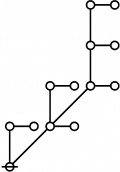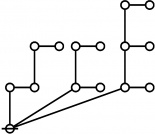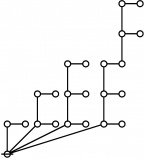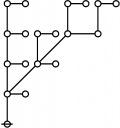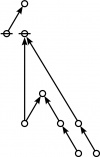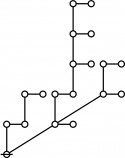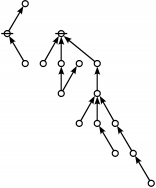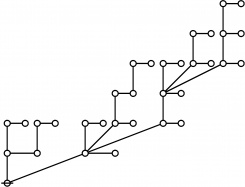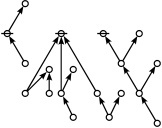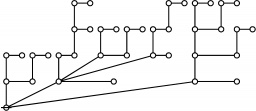Difference between revisions of "Directory:Jon Awbrey/Papers/Riffs and Rotes"
Jon Awbrey (talk | contribs) (→Miscellaneous Examples: adjust image width) |
Jon Awbrey (talk | contribs) (update) |
||
| (13 intermediate revisions by the same user not shown) | |||
| Line 48: | Line 48: | ||
Each index <math>i\!</math> and exponent <math>j\!</math> appearing in the prime factorization of a positive integer <math>n\!</math> is itself a positive integer, and thus has a prime factorization of its own. | Each index <math>i\!</math> and exponent <math>j\!</math> appearing in the prime factorization of a positive integer <math>n\!</math> is itself a positive integer, and thus has a prime factorization of its own. | ||
| − | Continuing with the same example, the index <math>504\!</math> has the factorization <math>2^3 \cdot 3^2 \cdot 7 = \text{p}_1^3 \text{p}_2^2 \text{p}_4^1\!</math> and the index <math>529\!</math> has the factorization <math>{23}^2 = \text{p}_9^2.\!</math> Taking this information together with previously known factorizations allows the following replacements to be made in the above | + | Continuing with the same example, the index <math>504\!</math> has the factorization <math>2^3 \cdot 3^2 \cdot 7 = \text{p}_1^3 \text{p}_2^2 \text{p}_4^1\!</math> and the index <math>529\!</math> has the factorization <math>{23}^2 = \text{p}_9^2.\!</math> Taking this information together with previously known factorizations allows the following replacements to be made in the expression above: |
{| align="center" cellpadding="6" width="90%" | {| align="center" cellpadding="6" width="90%" | ||
| Line 113: | Line 113: | ||
| align=center | [[Image:Rote 123456789 Big.jpg|345px]] | | align=center | [[Image:Rote 123456789 Big.jpg|345px]] | ||
|} | |} | ||
| − | |||
| − | |||
==Riffs in Numerical Order== | ==Riffs in Numerical Order== | ||
| − | {| align="center" border="1" cellpadding=" | + | {| align="center" border="1" cellpadding="12" |
|+ style="height:25px" | <math>\text{Riffs in Numerical Order}\!</math> | |+ style="height:25px" | <math>\text{Riffs in Numerical Order}\!</math> | ||
| valign="bottom" | | | valign="bottom" | | ||
| Line 376: | Line 374: | ||
{| align="center" border="1" cellpadding="6" | {| align="center" border="1" cellpadding="6" | ||
| + | |+ style="height:25px" | <math>\text{Rotes in Numerical Order}\!</math> | ||
| valign="bottom" | | | valign="bottom" | | ||
<p>[[Image:Rote 1 Big.jpg|20px]]</p><br> | <p>[[Image:Rote 1 Big.jpg|20px]]</p><br> | ||
| Line 629: | Line 628: | ||
|} | |} | ||
| − | ==Prime | + | ==Prime Animations== |
| − | ===Riffs=== | + | ===Riffs 1 to 60=== |
| − | + | {| align="center" | |
| − | + | | [[Image:Animation Riff 60 x 0.16.gif]] | |
| − | + | |} | |
| − | + | ===Rotes 1 to 60=== | |
| − | |||
| − | |||
| − | + | {| align="center" | |
| − | + | | [[Image:Animation Rote 60 x 0.16.gif]] | |
| − | + | |} | |
| − | |||
| − | |||
| − | |||
| − | |||
| − | |||
| − | |||
==Selected Sequences== | ==Selected Sequences== | ||
| Line 659: | Line 650: | ||
* '''Number of "rooted odd trees with only exponent symmetries" (Rotes) on 2n+1 nodes.''' | * '''Number of "rooted odd trees with only exponent symmetries" (Rotes) on 2n+1 nodes.''' | ||
| − | * [http://oeis.org | + | * [http://oeis.org/A061396 OEIS Entry for A061396]. |
{| align="center" border="1" width="96%" | {| align="center" border="1" width="96%" | ||
| Line 799: | Line 790: | ||
* '''Triangle in which k-th row lists natural number values for the collection of riffs with k nodes.''' | * '''Triangle in which k-th row lists natural number values for the collection of riffs with k nodes.''' | ||
| − | * [http://oeis.org | + | * [http://oeis.org/A062504 OEIS Entry for A062504]. |
{| align="center" | {| align="center" | ||
| Line 1,204: | Line 1,195: | ||
* '''Nodes in riff (rooted index-functional forest) for n.''' | * '''Nodes in riff (rooted index-functional forest) for n.''' | ||
| − | * [http://oeis.org | + | * [http://oeis.org/A062537 OEIS Entry for A062537]. |
{| align="center" border="1" cellpadding="10" | {| align="center" border="1" cellpadding="10" | ||
| Line 1,465: | Line 1,456: | ||
* '''Smallest j with n nodes in its riff (rooted index-functional forest).''' | * '''Smallest j with n nodes in its riff (rooted index-functional forest).''' | ||
| − | * [http://oeis.org | + | * [http://oeis.org/A062860 OEIS Entry for A062860]. |
{| align="center" border="1" cellpadding="10" | {| align="center" border="1" cellpadding="10" | ||
| Line 1,516: | Line 1,507: | ||
* '''a(n) = rhig(n) = rote height in gammas of n, where the "rote" corresponding to a positive integer n is a graph derived from the primes factorization of n, as illustrated in the comments.''' | * '''a(n) = rhig(n) = rote height in gammas of n, where the "rote" corresponding to a positive integer n is a graph derived from the primes factorization of n, as illustrated in the comments.''' | ||
| − | * [http://oeis.org | + | * [http://oeis.org/A109301 OEIS Entry for A109301]. |
; Example | ; Example | ||
| Line 1,835: | Line 1,826: | ||
| width="10%" | <math>1\!</math> | | width="10%" | <math>1\!</math> | ||
| width="45%" | | | width="45%" | | ||
| − | | width="45%" | [[Image:Rote 1 Big.jpg| | + | | width="45%" | [[Image:Rote 1 Big.jpg|15px]] |
|- | |- | ||
| <math>2\!</math> | | <math>2\!</math> | ||
| − | | [[Image:Riff 2 Big.jpg| | + | | [[Image:Riff 2 Big.jpg|15px]] |
| − | | [[Image:Rote 2 Big.jpg| | + | | [[Image:Rote 2 Big.jpg|30px]] |
|- | |- | ||
| <math>3\!</math> | | <math>3\!</math> | ||
| − | | [[Image:Riff 3 Big.jpg| | + | | [[Image:Riff 3 Big.jpg|30px]] |
| − | | [[Image:Rote 3 Big.jpg| | + | | [[Image:Rote 3 Big.jpg|30px]] |
|- | |- | ||
| <math>4\!</math> | | <math>4\!</math> | ||
| − | | [[Image:Riff 4 Big.jpg| | + | | [[Image:Riff 4 Big.jpg|30px]] |
| − | | [[Image:Rote 4 Big.jpg| | + | | [[Image:Rote 4 Big.jpg|48px]] |
| + | |- | ||
| + | | <math>360\!</math> | ||
| + | | [[Image:Riff 360 Big.jpg|120px]] | ||
| + | | [[Image:Rote 360 Big.jpg|135px]] | ||
|- | |- | ||
| <math>2010\!</math> | | <math>2010\!</math> | ||
| − | | [[Image:Riff 2010 Big.jpg| | + | | [[Image:Riff 2010 Big.jpg|138px]] |
| − | | [[Image:Rote 2010 Big.jpg| | + | | [[Image:Rote 2010 Big.jpg|144px]] |
|- | |- | ||
| <math>2011\!</math> | | <math>2011\!</math> | ||
| − | | [[Image:Riff 2011 Big.jpg| | + | | [[Image:Riff 2011 Big.jpg|84px]] |
| − | | [[Image:Rote 2011 Big.jpg| | + | | [[Image:Rote 2011 Big.jpg|120px]] |
| + | |- | ||
| + | | <math>2012\!</math> | ||
| + | | [[Image:Riff 2012 Big.jpg|100px]] | ||
| + | | [[Image:Rote 2012 Big.jpg|125px]] | ||
|- | |- | ||
| <math>2500\!</math> | | <math>2500\!</math> | ||
| − | | [[Image:Riff 2500 Big.jpg| | + | | [[Image:Riff 2500 Big.jpg|66px]] |
| − | | [[Image:Rote 2500 Big.jpg| | + | | [[Image:Rote 2500 Big.jpg|125px]] |
| + | |- | ||
| + | | <math>802701\!</math> | ||
| + | | [[Image:Riff 802701 Big.jpg|156px]] | ||
| + | | [[Image:Rote 802701 Big.jpg|245px]] | ||
| + | |- | ||
| + | | <math>123456789\!</math> | ||
| + | | [[Image:Riff 123456789 Big.jpg|162px]] | ||
| + | | [[Image:Rote 123456789 Big.jpg|256px]] | ||
|} | |} | ||
|} | |} | ||
Latest revision as of 22:00, 30 January 2016
Idea
Let \(\text{p}_i\!\) be the \(i^\text{th}\!\) prime, where the positive integer \(i\!\) is called the index of the prime \(\text{p}_i\!\) and the indices are taken in such a way that \(\text{p}_1 = 2.\!\) Thus the sequence of primes begins as follows:
|
\(\begin{matrix} \text{p}_1 = 2, & \text{p}_2 = 3, & \text{p}_3 = 5, & \text{p}_4 = 7, & \text{p}_5 = 11, & \text{p}_6 = 13, & \text{p}_7 = 17, & \text{p}_8 = 19, & \ldots \end{matrix}\) |
The prime factorization of a positive integer \(n\!\) can be written in the following form:
| \(n ~=~ \prod_{k = 1}^{\ell} \text{p}_{i(k)}^{j(k)},\!\) |
where \(\text{p}_{i(k)}^{j(k)}\!\) is the \(k^\text{th}\!\) prime power in the factorization and \(\ell\!\) is the number of distinct prime factors dividing \(n.\!\) The factorization of \(1\!\) is defined as \(1\!\) in accord with the convention that an empty product is equal to \(1.\!\)
Let \(I(n)\!\) be the set of indices of primes that divide \(n\!\) and let \(j(i, n)\!\) be the number of times that \(\text{p}_i\!\) divides \(n.\!\) Then the prime factorization of \(n\!\) can be written in the following alternative form:
| \(n ~=~ \prod_{i \in I(n)} \text{p}_{i}^{j(i, n)}.\!\) |
For example:
|
\(\begin{matrix} 123456789 & = & 3^2 \cdot 3607 \cdot 3803 & = & \text{p}_2^2 \text{p}_{504}^1 \text{p}_{529}^1. \end{matrix}\) |
Each index \(i\!\) and exponent \(j\!\) appearing in the prime factorization of a positive integer \(n\!\) is itself a positive integer, and thus has a prime factorization of its own.
Continuing with the same example, the index \(504\!\) has the factorization \(2^3 \cdot 3^2 \cdot 7 = \text{p}_1^3 \text{p}_2^2 \text{p}_4^1\!\) and the index \(529\!\) has the factorization \({23}^2 = \text{p}_9^2.\!\) Taking this information together with previously known factorizations allows the following replacements to be made in the expression above:
|
\(\begin{array}{rcl} 2 & \mapsto & \text{p}_1^1 \'"`UNIQ-MathJax1-QINU`"' '"`UNIQ-MathJax2-QINU`"' '"`UNIQ-MathJax3-QINU`"' '"`UNIQ-MathJax4-QINU`"' :{| border="1" cellpadding="20" | [[Image:Rote 802701 Big.jpg|330px]] |} '"`UNIQ-MathJax5-QINU`"' <br> {| align="center" border="1" cellpadding="6" |+ style="height:25px" | \(a(n) = \text{Rote Height of}~ n\) |
\(1\!\) \(a(1) ~=~ 0\) |
\(\text{p}\!\) \(a(2) ~=~ 1\) |
\(\text{p}_\text{p}\!\) \(a(3) ~=~ 2\) |
\(\text{p}^\text{p}\!\) \(a(4) ~=~ 2\) |
\(\text{p}_{\text{p}_\text{p}}\!\) \(a(5) ~=~ 3\) |
|
\(\text{p} \text{p}_\text{p}\!\) \(a(6) ~=~ 2\) |
\(\text{p}_{\text{p}^\text{p}}\!\) \(a(7) ~=~ 3\) |
\(\text{p}^{\text{p}_\text{p}}\!\) \(a(8) ~=~ 3\) |
\(\text{p}_\text{p}^\text{p}\!\) \(a(9) ~=~ 2\) |
\(\text{p} \text{p}_{\text{p}_\text{p}}\!\) \(a(10) ~=~ 3\) | |
|
\(\text{p}_{\text{p}_{\text{p}_\text{p}}}\!\) \(a(11) ~=~ 4\) |
\(\text{p}^\text{p} \text{p}_\text{p}\!\) \(a(12) ~=~ 2\) |
\(\text{p}_{\text{p} \text{p}_\text{p}}\!\) \(a(13) ~=~ 3\) |
\(\text{p} \text{p}_{\text{p}^\text{p}}\!\) \(a(14) ~=~ 3\) |
\(\text{p}_\text{p} \text{p}_{\text{p}_\text{p}}\!\) \(a(15) ~=~ 3\) | |
|
\(\text{p}^{\text{p}^\text{p}}\!\) \(a(16) ~=~ 3\) |
\(\text{p}_{\text{p}_{\text{p}^\text{p}}}\!\) \(a(17) ~=~ 4\) |
\(\text{p} \text{p}_\text{p}^\text{p}\!\) \(a(18) ~=~ 2\) |
\(\text{p}_{\text{p}^{\text{p}_\text{p}}}\!\) \(a(19) ~=~ 4\) |
\(\text{p}^\text{p} \text{p}_{\text{p}_\text{p}}\!\) \(a(20) ~=~ 3\) | |
|
\(\text{p}_\text{p} \text{p}_{\text{p}^\text{p}}\!\) \(a(21) ~=~ 3\) |
\(\text{p} \text{p}_{\text{p}_{\text{p}_\text{p}}}\!\) \(a(22) ~=~ 4\) |
\(\text{p}_{\text{p}_\text{p}^\text{p}}\!\) \(a(23) ~=~ 3\) |
\(\text{p}^{\text{p}_\text{p}} \text{p}_\text{p}\!\) \(a(24) ~=~ 3\) |
\(\text{p}_{\text{p}_\text{p}}^\text{p}\!\) \(a(25) ~=~ 3\) | |
|
\(\text{p} \text{p}_{\text{p} \text{p}_\text{p}}\!\) \(a(26) ~=~ 3\) |
\(\text{p}_\text{p}^{\text{p}_\text{p}}\!\) \(a(27) ~=~ 3\) |
\(\text{p}^\text{p} \text{p}_{\text{p}^\text{p}}\!\) \(a(28) ~=~ 3\) |
\(\text{p}_{\text{p} \text{p}_{\text{p}_\text{p}}}\!\) \(a(29) ~=~ 4\) |
\(\text{p} \text{p}_\text{p} \text{p}_{\text{p}_\text{p}}\!\) \(a(30) ~=~ 3\) | |
|
\(\text{p}_{\text{p}_{\text{p}_{\text{p}_\text{p}}}}\!\) \(a(31) ~=~ 5\) |
\(\text{p}^{\text{p}_{\text{p}_\text{p}}}\!\) \(a(32) ~=~ 4\) |
\(\text{p}_\text{p} \text{p}_{\text{p}_{\text{p}_\text{p}}}\!\) \(a(33) ~=~ 4\) |
\(\text{p} \text{p}_{\text{p}_{\text{p}^\text{p}}}\!\) \(a(34) ~=~ 4\) |
\(\text{p}_{\text{p}_\text{p}} \text{p}_{\text{p}^\text{p}}\!\) \(a(35) ~=~ 3\) | |
|
\(\text{p}^\text{p} \text{p}_\text{p}^\text{p}\!\) \(a(36) ~=~ 2\) |
\(\text{p}_{\text{p}^\text{p} \text{p}_\text{p}}\!\) \(a(37) ~=~ 3\) |
\(\text{p} \text{p}_{\text{p}^{\text{p}_\text{p}}}\!\) \(a(38) ~=~ 4\) |
\(\text{p}_\text{p} \text{p}_{\text{p} \text{p}_\text{p}}\!\) \(a(39) ~=~ 3\) |
\(\text{p}^{\text{p}_\text{p}} \text{p}_{\text{p}_\text{p}}\!\) \(a(40) ~=~ 3\) | |
|
\(\text{p}_{\text{p}_{\text{p} \text{p}_\text{p}}}\!\) \(a(41) ~=~ 4\) |
\(\text{p} \text{p}_\text{p} \text{p}_{\text{p}^\text{p}}\!\) \(a(42) ~=~ 3\) |
\(\text{p}_{\text{p} \text{p}_{\text{p}^\text{p}}}\!\) \(a(43) ~=~ 4\) |
\(\text{p}^\text{p} \text{p}_{\text{p}_{\text{p}_\text{p}}}\!\) \(a(44) ~=~ 4\) |
\(\text{p}_\text{p}^\text{p} \text{p}_{\text{p}_\text{p}}\!\) \(a(45) ~=~ 3\) | |
|
\(\text{p} \text{p}_{\text{p}_\text{p}^\text{p}}\!\) \(a(46) ~=~ 3\) |
\(\text{p}_{\text{p}_\text{p} \text{p}_{\text{p}_\text{p}}}\!\) \(a(47) ~=~ 4\) |
\(\text{p}^{\text{p}^\text{p}} \text{p}_\text{p}\!\) \(a(48) ~=~ 3\) |
\(\text{p}_{\text{p}^\text{p}}^\text{p}\!\) \(a(49) ~=~ 3\) |
\(\text{p} \text{p}_{\text{p}_\text{p}}^\text{p}\!\) \(a(50) ~=~ 3\) | |
|
\(\text{p}_\text{p} \text{p}_{\text{p}_{\text{p}^\text{p}}}\!\) \(a(51) ~=~ 4\) |
\(\text{p}^\text{p} \text{p}_{\text{p} \text{p}_\text{p}}\!\) \(a(52) ~=~ 3\) |
\(\text{p}_{\text{p}^{\text{p}^\text{p}}}\!\) \(a(53) ~=~ 4\) |
\(\text{p} \text{p}_\text{p}^{\text{p}_\text{p}}\!\) \(a(54) ~=~ 3\) |
\(\text{p}_{\text{p}_\text{p}} \text{p}_{\text{p}_{\text{p}_\text{p}}}\!\) \(a(55) ~=~ 4\) | |
|
\(\text{p}^{\text{p}_\text{p}} \text{p}_{\text{p}^\text{p}}\!\) \(a(56) ~=~ 3\) |
\(\text{p}_\text{p} \text{p}_{\text{p}^{\text{p}_\text{p}}}\!\) \(a(57) ~=~ 4\) |
\(\text{p} \text{p}_{\text{p} \text{p}_{\text{p}_\text{p}}}\!\) \(a(58) ~=~ 4\) |
\(\text{p}_{\text{p}_{\text{p}_{\text{p}^\text{p}}}}\!\) \(a(59) ~=~ 5\) |
\(\text{p}^\text{p} \text{p}_\text{p} \text{p}_{\text{p}_\text{p}}\!\) \(a(60) ~=~ 3\) |
Miscellaneous Examples
| |||||||||||||||||||||||||||||||||
|








